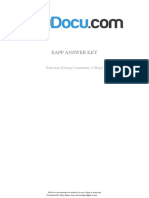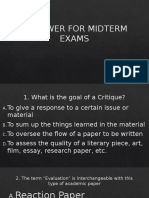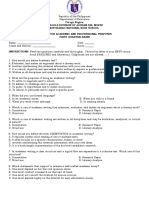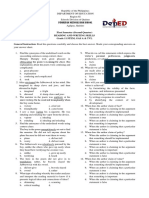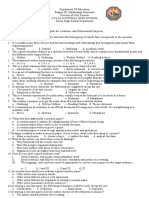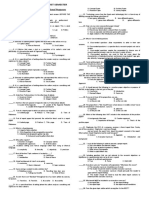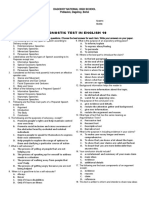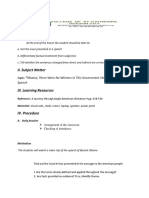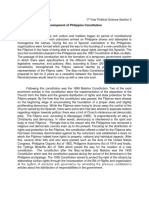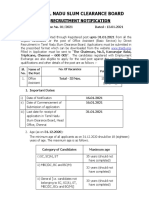Summative Test in B. “The essay discusses bullying, its effects, and solutions.
”
English for Academic Purposes C. “The essay has many words about bullying.”
D. “I don’t like bullying.”
19. Which of the following is NOT a step in summarizing?
I. Differentiates language used in academic texts from various A. Identify main ideas B. Use your own words
disciplines in English C. Eliminate minor details D. Insert your opinions
Direction: Choose the best answer. 20. If a teacher asks you to shorten a 2-page article into a
1. Which of the following is an example of academic English? paragraph, you are asked to:
A. “The poem was, like, super cool.” A. Paraphrase B. Summarize
B. “The poem uses imagery to express sadness.” C. Expand D. Narrate
C. “The poem was boring, honestly.” IV. Identifying thesis statements
D. “The poem is kinda confusing.” Direction: Read and extract the thesis statement.
2. Which sentence shows objective academic tone? 21. Reading literature is more than just an enjoyable pastime; it is
A. “The short story is stupid.” a way to develop empathy and understanding. By entering
B. “The story illustrates themes of courage and betrayal.” the world of stories, readers are exposed to the lives,
C. “I didn’t like the short story at all.” struggles, and emotions of characters who may be very
D. “The short story is awesome.” different from themselves. This experience allows them to
3. Academic writing in English usually avoids: broaden their perspectives and learn compassion.
A. Formal vocabulary B. First-person slang 22.Social media has become an important part of the lives of
C. Cohesive devices D. Topic sentences students today. It helps them communicate with friends, stay
4. Which of the following is written in a formal academic style? informed, and even learn new skills. However, social media
A. “The play was cool and had great vibes.” also has harmful effects when it is overused, such as
B. “The play effectively portrays human struggle through decreased focus on studies, exposure to fake news, and
symbolism.” cyberbullying.
C. “That play was fire!” 23. Many novels portray how human flaws can destroy
D. “The play is kinda nice.” relationships, and greed is one of the most common themes.
5. Academic English often makes use of: Characters who place wealth and possessions above family
A. Precise language and formal tone B. Slang and emojis ties often lose what truly matters in life. Readers can learn
C. Gossip and rumors D. Random abbreviations valuable lessons by observing how greed corrupts individuals
6. In academic writing, instead of writing “kids,” the writer should and breaks apart families.
use: 24.Reading comprehension is a fundamental skill for every
A. “lads” B. “children” student without it learners cannot understand instructions,
C. “kiddos” D. “tykes” analyze texts, or perform well in school activities. Strong
7. Which statement uses the correct academic English tone? reading comprehension also helps in other subjects like
A. “Shakespeare is a legend.” Science, Math, and History since all require understanding of
B. “Shakespeare’s works reveal the complexities of human written material.
nature.” 25.The rise of technology has greatly changed the way students
C. “Shakespeare is overrated.” learn. Online platforms, video lessons, and digital resources
D. “Shakespeare is cool.” now make learning more accessible to everyone. However,
8. In academic texts, contractions such as don’t and can’t are many online classes still lack interactivity, leaving students
usually replaced with: passive instead of engaged.
A. do not, cannot B. dnt, cnt V. Critical writing approaches (Formalism & Feminism) (Items
C. don’tcha, can’tcha D. dunno, can’t 26.Formalism focuses on:
9. Which is not an example of academic English? A. Author’s life B. The text itself—form and structure
A. “The text conveys the struggles of marginalized groups.” C. Reader’s feelings D. Society’s influence
B. “The novel demonstrates a clear use of irony.” 27.A feminist critique asks:
C. “The poem was kinda meh.” A. “How do gender roles appear in this text?”
D. “The essay analyzes the role of imagery.” B. “How many times does the word repeat?”
10. Academic English is different from casual language because it C. “What inspired the author?”
is: D. “What is the historical context?”
A. Informal and humorous B. Objective and precise 28.Formalist critics examine:
C. Full of slang D. Relaxed and conversational A. Word choice, imagery, symbols B. Author’s diary
II. Uses knowledge of text structure C. Reader’s opinion D. Author’s family
Direction: Identify the text structure. 29.A feminist critique of Cinderella might say:
11. “First, the writer introduces the problem. Then, evidence is A. “The fairy godmother is a symbol of hope.”
presented. Finally, the solution is offered.” → __________ B. “The story reinforces stereotypes about women needing
12. “Both the poem and the short story address love, but they do rescue.”
so in different ways.” → __________ C. “The plot structure is linear.”
13. “Because the character lied, he lost his friends.” → D. “The story reminds me of my life.”
__________ 30.Formalism treats a text as:
14. “The essay discusses imagery, symbolism, and tone in the A. Independent work with patterns and meaning
poem.” → __________ B. Reflection of history only
15. “The author narrates events in order: childhood, teenage C. Biographical evidence
years, and adulthood.” → __________ D. A diary entry
III. Summarizing texts (Items 16–20) 31. Feminism is concerned with:
Direction: Multiple choice. A. Representation of women B. Sentence structure
16.Summarizing means: C. Imagery only D. Sound devices
A. Copying the entire passage B. Restating the main idea briefly 32. A formalist analysis of a poem focuses on:
C. Writing the text word-for-word D. Expanding the details A. Rhyme, rhythm, symbolism B. Gender bias
17. A good summary should: C. Society’s influence D. Author’s experiences
A. Be shorter than the original B. Contain personal opinion 33. A feminist reading of a novel asks:
C. Use slang and informal tone D. Include every small detail A. “Are female characters given equal voice?”
18. Which is the best summary of a 5-paragraph essay on B. “What symbols are repeated?”
bullying? C. “What is the rhyme scheme?”
A. “Bullying is bad.” D. “What’s the climax?”
�34. Which of the following is not a feminist concern?
A. Stereotypes of women
B. Inequality in roles
C. Use of irony and metaphor only
D. Women’s silenced voices
35. Which is a formalist critique?
A. “The poem shows repetition of words to emphasize pain.”
B. “The author was poor, so he wrote about poverty.”
C. “The novel reflects women’s struggles in society.”
D. “I like this poem because it’s sad.”
VI. Writing objective/balanced review
36. A critique must be:
A. Biased B. Objective and fair
C. One-sided D. Emotional only
37. Which is an objective review?
A. “This story is trash.”
B. “The play uses irony to highlight conflict.”
C. “I hate this character.”
D. “This is the best ever.”
38. Which shows bias?
A. “The essay uses examples to explain the idea.”
B. “The short story is ugly and worthless.”
C. “The poem demonstrates use of metaphor.”
D. “The reviewer notes both strengths and weaknesses.”
39. A balanced review should include:
A. Strengths only
B. Weaknesses only
C. Both strengths and weaknesses
D. None
40. Which is the most objective statement?
A. “The essay was boring.”
B. “The article presented evidence clearly and logically.”
C. “The story is the worst ever.”
D. “The poem is awesome.”
41. What makes a critique objective?
A. Supported by evidence B. Based on personal likes
C. Based on gossip D. Based on exaggeration
42. Which review is balanced?
A. “The short story is the best.”
B. “The performance showed creativity, but pacing was slow.”
C. “The article is useless.”
D. “The novel is perfect.”
43. A reviewer writes: “The poem’s imagery is strong, but its
conclusion is weak.” This is:
A. Biased B. Balanced
C. Emotional D. Subjective only
44. A critique must be supported by:
A. Evidence B. Rumors
C. Insults D. Feelings only
45. The main goal of critique writing is:
A. To attack the writer B. To praise excessively
C. To provide fair analysis D. To express gossip
VII. Make an outline about the topics discussed in our English
for Academic Purposes class. (5pts)
ENGLISH FOR ACADEMIC PURPOSES TOPICS


